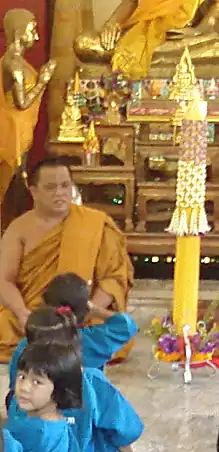Vassa
The Vassa (Pali: vassa-, Sanskrit: varṣa-, both "rain") is the three-month annual retreat observed by Theravada practitioners. Taking place during the wet season, Vassa lasts for three lunar months, usually from July (the Burmese month of Waso, ဝါဆို) to October (the Burmese month of Thadingyut သီတင်းကျွတ်).[1]
| Translations of Vassa | |
|---|---|
| English | rain |
| Burmese | ဝါတွင်း [wàdwíɰ̃] |
| Chinese | 结夏安居 (Pinyin: Jié xià ānjū) |
| Khmer | វស្សា, ព្រះវស្សា (Vossa, Preah Vossa) |
| Lao | ພັນສາ, ວັດສາ [pʰán sǎː], Watsa |
| Tibetan | དབྱར་གནས (Yarne) |
| Thai | พรรษา, วรรษา RTGS: phansa, pronounced [pʰān.sǎː] RTGS: watsa |
| Glossary of Buddhism | |
| Part of a series on |
| Buddhism |
|---|
 |
|

In English, Vassa is often glossed as Rains Retreat[2] or Buddhist Lent,[3] the latter by analogy to the Christian Lent (which Vassa predates by at least five centuries).
For the duration of Vassa, monastics remain in one place, typically a monastery or temple grounds.[4][5] In some monasteries, monks dedicate the Vassa to intensive meditation.[4] Some Buddhist lay people choose to observe Vassa by adopting more ascetic practices, such as giving up meat, alcohol, or smoking.[1] In Thailand, the sale of alcohol is prohibited on the first and last days of Vassa, known as "Khao Phansa" and "Wan Ok Phansa".[6] While Vassa is sometimes casually called "Buddhist Lent", others object to this terminology.[4] Commonly, the number of years a monk has spent in monastic life is expressed by counting the number of vassas (or rains) since ordination.
Most Mahayana Buddhists do not observe Vassa, though Vietnamese Thiền and Korean Seon monastics observe an equivalent retreat of three months of intensive practice in one location, a practice also observed in Tibetan Buddhism.
Vassa begins on the first day of the waning moon of the eighth lunar month, which is the day after Asalha Puja or Asalha Uposatha ("Dhamma day"). It ends on Pavarana, when all monastics come before the sangha and atone for any offense that might have been committed during Vassa.
Vassa is followed by Kathina, a festival in which the laity expresses gratitude to monks.[7][8] Lay Buddhists bring donations to temples, especially new robes for the monks.[7][8][9]
The Vassa tradition predates the time of Gautama Buddha.[1] It was a long-standing custom for mendicant ascetics in India not to travel during the rainy season as they may unintentionally harm crops, insects or even themselves during their travels.[4] Many Buddhist ascetics live in regions which lack a rainy season.[8] Consequently, there are places where Vassa may not be typically observed.[8]
References
- Vassa at About.com
- "Vassa". Archived from the original on 2010-03-23. Retrieved 2010-10-14.
- Thein, Cherry (14–20 July 2008). "Shwedagon Pagoda marks the start of Buddhist Lent this week". The Myanmar Times. Archived from the original on 21 September 2011. Retrieved 15 July 2011.
- Lay Buddhist Practice - The Shrine Room, Uposatha Day, Rains Residence
- Was (Thai) Vassa
- "Religious holidays bring two alcohol ban days, four-day weekend". The Phuket News. Retrieved 7 January 2021.
- Vassa (Rains Retreat) and Kathina (Robe Offering) Ceremony
- Vassa, The Rains Retreat
- Kathina at BBC
| Wikimedia Commons has media related to Vassa. |